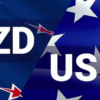
The British Pound (GBP) remains resilient against the U.S. Dollar (USD), trading around 1.3520 during Wednesday’s European session. The GBP/USD pair maintains its upward momentum despite renewed trade activity between Washington and Tokyo, as the Greenback struggles to regain strength.
Dollar Struggles Despite Fresh U.S.-Japan Trade Agreement
The U.S. Dollar Index (DXY), which measures the value of the dollar against a basket of six major currencies, hovers around 97.45—just above Tuesday’s two-week low of 97.30. Even the announcement of a new trade deal between the U.S. and Japan has failed to lift the dollar meaningfully.
President Donald Trump confirmed via a post on Truth.Social that the U.S. has secured a trade deal with Japan. Under the agreement, Japan will open its economy to key American exports—including automobiles, rice, and other agricultural goods—while accepting 15% reciprocal tariffs on goods exported to the United States. Trump also revealed that Japan has committed to invest $550 billion in the U.S. economy.
“Japan will open their Country to Trade including Cars and Trucks, Rice and certain other Agricultural Products, and other things,” Trump said. “Japan will pay Reciprocal Tariffs to the United States of 15%.”
This trade agreement arrives at a politically uncertain time for Japan, following Prime Minister Shigeru Ishiba’s announcement that he will resign by the end of August. Adding to the diplomatic flurry, the U.S. also sealed a separate bilateral trade agreement with the Philippines on Tuesday.
Pound Sterling Steady Ahead of Key UK PMI Data
The British Pound is showing strength against most major currencies—except the antipodean pairs—ahead of Thursday’s release of the preliminary S&P Global Purchasing Managers’ Index (PMI) data for July. Economists forecast the UK Composite PMI to tick down slightly to 51.9 from June’s reading of 52.0, signaling that business activity remains in expansion territory but continues to slow.
One focal point for investors will be hiring trends in the UK’s private sector. Recent data shows that employers have scaled back hiring, citing rising social security costs and broader economic uncertainty.
Fiscal and Monetary Policy in the Spotlight
The UK’s fiscal position has come under scrutiny after the Office for National Statistics (ONS) reported that the government posted its second-highest borrowing total since 1993. The borrowing spike is largely attributed to increased interest costs fueled by persistent inflation. Analysts suggest that this development may push the government toward announcing new tax measures in the upcoming Autumn Statement.
On the monetary policy front, expectations are growing that the Bank of England (BoE) could implement a rate cut in August. Several major financial institutions, including Bank of America, Citigroup, Morgan Stanley, and Goldman Sachs, are forecasting a 25 basis point cut in the next policy meeting. With inflation cooling and economic growth under pressure, the BoE may pivot toward easing policy to support demand.
U.S. PMI Data and Fed Rate Cut Outlook
Looking ahead, market participants are also awaiting Thursday’s release of U.S. flash PMI data. Economists expect improvements in both the manufacturing and services sectors, which could offer some support to the USD if confirmed.
However, rate cut expectations for the Federal Reserve’s September meeting have cooled in recent weeks. Analysts now believe the inflationary impact of Trump’s tariff policies is beginning to reflect in consumer prices, making the case for additional easing less urgent.
According to the CME FedWatch Tool, the probability of a Fed rate cut in September has dropped to 58.7%, down from 69.6% just a month ago.









